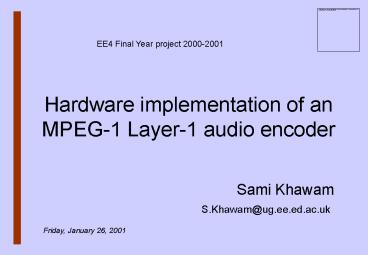Hardware implementation of an MPEG1 Layer1 audio encoder - PowerPoint PPT Presentation
1 / 21
Title:
Hardware implementation of an MPEG1 Layer1 audio encoder
Description:
Hardware core for MPEG-1, layer-1 (MP1) audio encoding. Description in Verilog-RTL for flexibility. Synthetisable to FPGA architecture. 5 ... – PowerPoint PPT presentation
Number of Views:50
Avg rating:3.0/5.0
Title: Hardware implementation of an MPEG1 Layer1 audio encoder
1
Hardware implementation of an MPEG-1 Layer-1
audio encoder
EE4 Final Year project 2000-2001
- Sami Khawam
S.Khawam_at_ug.ee.ed.ac.uk
Friday, January 26, 2001
2
Presentation Outline
- 1. Aims of the project
- 2. Overview of MPEG algorithm
- 3. Implementation
- 4. Project organisation
- 5. Further extensions and modifications
3
1. Aims of the project
4
Aims of the project
- Hardware core for MPEG-1, layer-1 (MP1) audio
encoding. - Description in Verilog-RTL for flexibility.
- Synthetisable to FPGA architecture.
5
Advantage
Commercial IP cores and chips exist, but are
mainly based on software and DSP cores. The
advantages in hardware
- High speed, thus real-time possibility.
- Lower power consumption.
- Low cost by using low cost FPGAs.
6
Applications
- Portable or standalone audio record and playback
devices. - Voice-over-IP systems.
- Standalone internet-radio servers.
7
2. Overview of MPEG algorithm
8
Encoding System
9
Analysis Filterbank
- Time to frequency domain conversion.
- Critically sampled 384 inputs, 384 outputs.
- 32 equal width subbands.
- Like parallel band-pass.
- Equation from ISO document
- Can be optimised
10
Psychoacoustic Model
- Key to maintain signal quality at high
compression ratios. - Based on absolute hearing threshold
- and the frequency masking properties of the ear.
- Finds the Signal-to-Mask Ratio value for each
subband.
11
SMR calculation outline
- 512-point FFT and window then squaring to get
power. - Identify tonal (sine like, local peaks) and
non-tonal (noise like) maskers. - Remove the ones that are blow the threshold of
hearing. - Remove weak tonal maskers too close to strong
maskers. - Find global masking threshold absolute
threshold contribution from maskers. - Find minimum masking threshold in each subband
(from individual masking threshold and GMT). - SMR of each subband MMT - Peak power of subband.
12
Bit allocation and Quantisation
- Find the minimum number of quantisation bits to
make the quantisation noise inaudible. - Uses iteration to find the minimum difference
between SMR and SNR. - Attempts to get the desired final bit rate.
- Then linearly quantise the subband samples.
13
Bitstream formatting
- Header
- For each of the 32 subbands
- number of bit allocated
- scale factor
- quantised samples
- Optional CRC error check.
14
3. Implementation
FPGA
PC
384 PCM frame
RS232
MPEG
RS232
driver
Encoder
Encoded data
- Audio encoded frame by frame
- PC sends PCM audio and receives the encoded data.
- Encoded data saved in .mp1 format by the PC.
15
4. Project Timeline
16
Second Term
- Build the 3 main components separately then
integrate them. - For each component
- Design the hardware based on C and Matlab source.
- Write adequate test-benches for simulation.
17
Third Term
- Implement the integrated blocks and RS232
transfers on the FPGA. - Write C program for transferring data between the
PC and the board. - Create test samples.
- Write documentation.
18
5. Further extensions and modifications
19
Problematic issues
- FPGA too small.
- Low memory availability of the FPGA external
DRAM needed. - Psychoacoustic model too design-time expensive.
20
Possible solutions
- Lower complexity psychoacoustic model. e.g. using
FFTs find the average sound power level for each
subband and treat result as SMR. - Computation of standard functions on the PC, e.g.
FFT in order to save memory and design time.
21
Further extension
- Support for layer 2.
- Implementation of decoder.
- Optimisation (speed and size) of single
components, e.g. like the filterbank.































